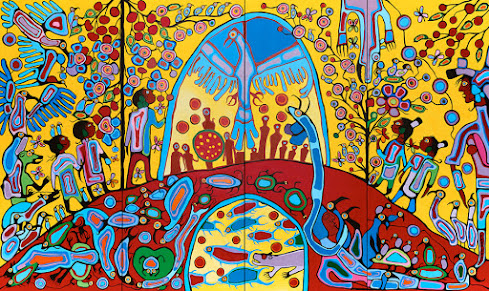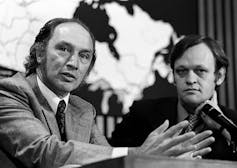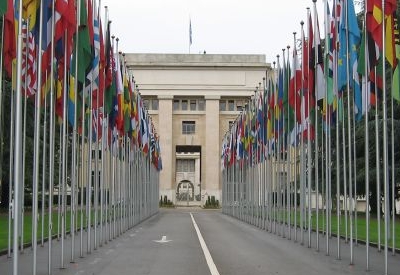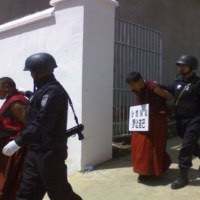Residential Schools: An ongoing Canadian tragedy
 |
| Norval Morrisseau "Androgyny"1983 Keywords: Truth & Reconciliation Commission, Residential School System, Canadian Government. |
"Many children did not survive. Thousands of children died in the schools. Thousands more were injured and traumatized. All were deprived of a measure of dignity and pride. We, as a country, lost the opportunity to create the nation we could have been."
Murray Sinclair 1
Introduction
Canada's defunct residential school system is exposing a dystopian element of Canadian history that has left Canada's international reputation with question marks. 1) How will the federal government compensate families who have lost loved ones. 2) How can the various levels of government improve living conditions on Native reserves. 3) The various levels of government need to develop a framework that empowers assimilation of Native Canadians outside of the First Nations reserve system. 4. Compensation needs to be determined for lost Native lands, and an exchange could be beneficial regarding #3 based on trust and economic incentives.
Respectfully, a comparison to the extermination of 6 million Jews at the hands of the Nazi Partly of Germany is not a fair comparison to the findings of innocent children dying in the Canadian residential school system and laying in unmarked graves. Both are unspeakable tragedies. In a Canadian context, where Canada was historically seen as peace-makers/ peace keepers, these findings are demeaning for Canadians and government officials. I would point to Tibet as an example of cultural genocide by their Chinese occupiers as a continued period of apartheid that is visible, if we can only get close enough inside Tibet, to gather facts on the ground to expose Sino - Tibet policy. Since 1949, over 1.2 million Tibetans have lost their lives during the Chinese occupation. In addition, over 6,000 monasteries have been destroyed and thousands have been imprisoned. Tragically, Native groups are finding mass unmarked graves using sonar equipment; work that the federal government should be doing to not delay these findings. The Canadian Prime Minister has made it his protocol to apologize for past misdemeanours such as Indigenous rights and those of Italian immigrants.
Derek Chauvin turns to the Floyd family after being sentenced to 22.5 years for his murder of George Floyd, and apologizes. Apologies provide lip service and do not resolve the concerns of gun violence, racial inequality, and income inequality. Justin Trudeau's words will go further if he can package them with tangible solutions.
In the early 2,000's I was visiting my sister and husband at their home in the area of Baden, Ontario. On this night, they had a Native - Canadian couple over for dinner, as well. My sister worked with the woman in the service sector and this woman was quite sociable. Her husband, had long black hair and stood back away from the group. I spoke with him about hockey and music, and he was a nice man. This couple lived in town with their two children. Last I had heard of them, they had returned to live on the Native Reserve.
The Canadian Prime Minster has increased immigration levels to over 300,000 annually during his time in office. Yet, the indigenous file keeps drawing government officials deeper into confusion despite the Truth and Reconciliation report in 2015. Canada must do more to assimilate Native - Canadians into the mainstream. After all, we lay out the "welcome mat" for new Canadians each year with a multitude of support systems that civil society provides. Native- Canadians on certain reserves have difficulty maintaining clean drinking water and proper housing. "Chief Emily Whetung and other Indigenous leaders have launched national class-action lawsuits against the federal government arguing the federal government failed to provide clean water and forced communities to live in a manner “consistent with life in developing countries.” They are suing the government for C$2.1bn (US1.7bn) damages – the costs associated with years of bottled water trucked and a water treatment system for the whole community.Again, the Prime Minister apologizes with no solution."2
The Truth & Reconciliation Commission Points
1) Staffing levels were inadequate and salaries were not high enough to retain teachers and recruit qualified teachers. . The hiring process for attaining qualified instructors was too slow. A key requirement was religious commitment. Ultimately, young teachers were overworked."In 1925, two teachers at the same school were responsible for 103 students: sixty in one class, forty-three in the other. p.358
2)Inspector R. H. Cairns: "Indian pupils will not do good work and maintain their health and strength if they are kept indoors too much." If the students were kept in class for five or six hours a day, he said, the school death rate was likely to increase, and he noted there had been four deaths in the previous year.
3)A very small number of residential school students continued their studies past Standard 6 (by the 1930s, referred to as "Grade Six"). p.369
4) By the mid 1930's "Indian Affairs was providing grants to 200 graduates of both residential schools and day schools to support them at high schools, universities, and business colleges. The policy may have been adopted in response to the early mortality of many students, since it was to provide "grants to the most promising physically fit graduates of our own schools." Students also had to meet very high academic standards to gain such financial support. p.369
5) An anecdote from Clayton Mack in 1923. He went got a residential school after his father passed away only to have the principle relegate his to general labour. "So I feed the horses, clean the barn, feed the cows and later even milk the cows. I get up at four o'clock in the morning sometimes and go look for them cows. I had ten cows. I'd get up, round them up, put them in the barn, feed them bran and then milk them. Then I have to get the milk ready for the Chinaman to pick up. Let the cows out for the day. In the summer it was really hard work. When the school closed in the summer they gave me the girls' cows too! The girls had about eight milk cows. So I did, looked after the whole works for two years. I also helped look after the farm, help with the potatoes, and helped cut the hay. I tried to go to school but there was not enough time. I worked most of the time. I went to Alert Bay for school and instead they put me in a job!":
6) The Great Depression forced schools to make do with less, and students became proxy labourers to help the schools survived financially. "In any workplace, young workers are at a high level of risk. They have less experience and skill than do older workers, their work is often repetitive and boring, and supervi¬ sion can be minimal. This was frequently the case in residential schools. The risks were greatest when students were used as a cheap source of labour, working with powerful and poorly protected machinery." p.390
7. Teachers, parents, and students contributed to the arts with meaningful and memorable contributions during their semesters. "The Sisters had created some sort of lighting effect causing the lights to turn into different colours, red, blue, and green. While the chorus sang in the background, "Nearer My God to Thee," the girls took different poses following the words of the hymn. Young as I was, I found it breath-taking and spectacular." p.397
8) High death rates during WW1 in Canada compelled the Canadian government to enlist Native Canadians for military duty. "It is estimated that over 4,000 people with status under the Indian Act—35% of the eligible population—served in the Canadian Expeditionary Force during the First World War. This is equivalent to the percentage of the general Canadian population that enlisted.169; p.414
9) Infections diseases such as Tuberculosis were causing mass fatalities among Aboriginals in Residential Schools. Louise Moine recollected how TB was a serious problem at Qu'Appelle school early in the 20th C. "There was a death every month on the girls' side and some of the boys went also. We were always taken to see the girls who had died. The Sisters invariably had them dressed in light blue and they always looked so peaceful and angelic. We were led to believe that their souls had gone to heaven, and this would somehow lessen the grief and sadness we felt in the loss of one of our little schoolmates." p.418 A graph shows that by 1957, residential school deaths of TB and influenza were negligible.
10) Students received poor quality of care which led to dissent among parents, school and government officials. "When children are taken sick at Industrial Schools they should be sent home so that their parents could look after them, and not be kept until they are ready to die, as generally the first thign [sic] parents hear is that their child is dead or at the point of death."102/ p.434.
Click link below for full report:
Truth and Reconciliation Report on Canadian Residential Schools
COVID and First Nation Reserves
As of June 22:
- the rate of reported active cases of COVID-19 in First Nations people living on-reserve is currently 148.9 per 100,000 or 6 times the respective rate in the general Canadian population
- the COVID-19 case fatality rate among First Nations people living on a reserve is 58% of the case fatality rate in the general Canadian population
- 97% of First Nations people living on a reserve who tested positive for COVID-19 have recovered
On First Nations reserves, as of June 25 Indigenous Services Canada (ISC) is aware of:
- 31,779 confirmed positive COVID-19
- 575 active cases
- 1,483 hospitalizations
- 30,847 recovered cases
- 357 deaths
The same story of human rights tragedies prevails from generation to generation. People being human, we're a self - interested lot and time offers no solution. Hobbes said the state of nature was the war of everyman against everyman. We could say that the pandemic has heightened that emotion. In fact, America is heading into an inflationary period with costs going up across the board. And, what occurs in the U.S. follows into Canada. So, we can expect interest rates to rise and this may be the pop that the housing bubble has been experiencing here in Canada. Unfortunately, some folks will lose their homes attributed to COVID job restructuring and an economic recalibration. Justin Trudeau is making noise about Parliament not working (when he decides to show up) with the prospectus for a FALL election looming as he wants a majority government to operate from. But, with that mandate can he manage the huge Canadian deficit, the ongoing Aboriginal residential school crisis, internal problems with his Ministers, past scandals that the opposition will be waiting to pounce on during the debates, and lets not forget the failed promise to institute a proportional representation voting network. A majority government may be wishful thinking at this juncture and the Conservatives appear poised to form a minority government if they can mobilize their base. The Liberal Party will ply voters with more incentives to vote for them. The wild card may be the separatist Bloc Quebecois that have a bona fide leader in Yves - Francois Blanchet who may steal Quebec away from the governing Liberals. If Trudeau can make it right for the Aboriginal community regarding the residential school crisis, create a job plan to help Canadians recovering from and entering the work force in a present and post COVID world , and be responsible with immigration when resources are diminished because of COVID, he has a shot at a majority. But, Canadians will need a short memory and a reason to start spending their accrued COVID savings.
Matthew Coon Come, Grand Chief of The Crees, said to the UN Commission on Human Rights: "Self -determination is a right which belongs to peoples. It does not belong to states. It is a right of all peoples. It is universal and non - divisible, that is, either you have it or you do not. It is not a right that is given to peoples by someone else. Please understand, you may have too fight to exercise this right, but you do not negotiate for the right of self - determination because it is yours already."3
Various groups of Canadian protesters have begun dismantling statues of former Prime Minister Sir John A MacDonald and founder of Ryerson University - Egerton Ryerson in light of the recent findings at Canadian residential schools. One local school in Waterloo will rename their school apart from the deposed former Prime Minister while the statue of Ryerson on campus bas been removed. Both figures helped design the residential school system. In fairness to Prime Minister Trudeau he appointed Murray Sinclair to the Canadian senate who was Chair of the Truth and Reconciliation Commission. Given are time Justin Trudeau may appoint the right people to atone for his predeccessors wrongdoings to Indigenous Canadians. Unfortunately, he squandered a perfect opportunity with the dismissal of Jody Wilson - Raybould, the Prime Minister's former Justice Minister, a member of the We Wai Kai Nation (British Columbia), and Aboriginal lawyer and former Attorney General of Canada, and is the daughter of Bill Wilson- a First Nation's Hereditary Chief. Moreover, his predecessor, Steven Harper set reconciliation with First Nations plummeting with the cancellation of the Kelowna Accord "... and the five billion dollar budget targeted to address the socio-economic gap between First Nations and other Canadians. That same year, shortly after issuing an apology for the residential schools and all the harm caused by taking away the languages and cultures of Indigenous peoples, Harper’s government cut funding for Indigenous languages. The following year, after apparently forgetting the more than 7,500 children who died in residential schools, Harper declared to the world that Canada has “no history of colonialism.”4 Former Prime Minister Harper failed indigenous peoples miserably as his predecessors.
Recently, a writer proclaimed that this situation constitutes genocide because those young students who died also fail to produce offspring to extend further generations of the Aboriginal community. This seems like a fair statement. Ultimately, it is time to dispense with the apologies and roll up our sleeves to foster improvement in the Aboriginal community in most ways that urban folks in Canada take for granted.
"The Conversation" an academic editorial noted on July 10, 2021" that "Former Prime Minister Pierre Trudeau Trudeau understood fully the conditions in which many Indigenous Peoples lived in 1969. Yet he found the notion of treaty rights between two groups within the same society or special status for any group at odds with his notion of common and equal citizenship."

"He and Jean Chrétien, his minister of Indian Affairs and Northern Development at the time, proposed in a white paper in 1969 that the special legal relationship between First Nations and the government of Canada be severed and all Indigenous Peoples fully integrated into Canadian life."
"The paper was met with forceful opposition from Indigenous leaders across the country and sparked a new era of Indigenous political organizing in Canada. Trudeau soon recognized that his largely assimilationist policy was not likely to convince anyone that it was either workable or just."
Current Prime Minister Justin Trudeau and Pierre's son has tried to apply salve to the situation by appointing Mary Simon as Canada's next Governor General, a ceremonial role that offers no solutions to the residential school imbroglio that is expanding as new discoveries turns up more unmarked children's graves. Simon can call for calm as Catholic churches are being burned too the ground in British Columbia. Ultimately, action is required or the credibility of Trudeau's government faces public pressure that will aid opposition parties in an expected Fall 2021 referendum.
People can access emotional and crisis referral services by calling the 24-hour national crisis line: 1-866-925-4419.
Works Cited
1Canada's Residential Schools; The History, Part One. Origins to 1939. The Final Report of the Truth and Reconciliation Commission of Canada. Volume 1. <https://publications.gc.ca/collections/collection_2015/trc/IR4-9-1-1-2015-eng.pdf>.
Murray Sinclair is a former Canadian senator and Aboriginal Attorney.
2Cecco, Leyland. Dozens of Canada’s First Nations lack drinking water: ‘Unacceptable in a country so rich.’ The Guardian. 30 April 2021. 27 June 2021. <https://www.theguardian.com/world/2021/apr/30/canada-first-nations-justin-trudeau-drinking-water>.
3Ignatieff, Michael. Blood and Belonging:Journey's Into The New Nationalism. Viking:1993. 06.28.2021. p. 125.
4Palmater, Pamela. "Harper’s 10 Year War on First Nations." 16 July 2015. 28 July 2021. <http://www.theharperdecade.com/blog/2015/7/14/harpers-10-year-war-on-first-nations>.




